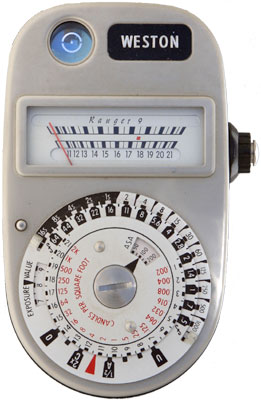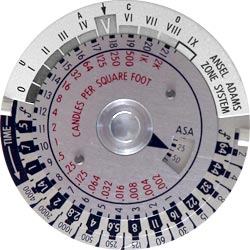
|
  Maker: Weston Instrument Model: Model 348 Ranger 9 Circa: 1966 Price (new): $69.95 Cell type: CdS Battery: one PX14 or two PX13 Measure type: Narrow field (18°) reflecting / averaging Modern Photography Review: February 1967 |
|
This was Weston's first and only CdS meter (the later XM models are by another company who licensed the Weston name), and it appears to be a good one. It got very good reviews, it was capable, and it had the Weston prestige to justify it's premium price. But for whatever reason, Weston had been pulling out of the commercial exposure meter market since the beginning of the 60s, and gave the market to the Germans and Japanese. This is an odd meter from a marketing standpoint. It's an 18° field averaging meter, and it's the first of its class, yet it's called the Ranger 9. Why? Why not just a Ranger? Or a Ranger 18? According to Modern Photography's review, they used "Ranger" as a tribute to the US space program, and 9 because it's the ninth in the line. (I've been counting, and I suppose it goes like this: Model 617 first version, Model 617 second version, Senior, Master, Master II, Master III, Master IV, and Master V. It's a stretch but that's the best I can come up with.) Personally, I think it's a variation of the Minolta View Meter 9. The big downside to this meter is that it takes two of the infamous PX13 mercury batteries, which cannot be had anymore, or one PX14 (which is twice the size and double the voltage). PX13s are 1.35v, and two of them make 2.7v, which can't be had either. So either you have to find two 1.35v hearing-aid batteries and make an adapter for them, or buy special Wein Cells, or have the meter recalibrated to use a modern PX625. (If you're handy with electronics and want to try to convert the meter yourself, take a look at this page on how to do it.) Or you could try out the Gossen Luna Pro battery adapter, which looks to me like it would work, but I haven't been able to get one and try it yet.
Best of all, you can figure this thing out easily without the instructions. There's a lock button for the calculator dial so you don't accidentally change the EI setting, but other than that it's straightforward. You hold it up and look through the little window next to the Weston badge. The full field is 18° and there's a bullseye in the center. You press the button on the side to take a reading. The black collar around the button selects the high-low scale, and only one scale is visible at a time so you always know what you're reading. The battery check switch on the back is clearly marked. This one also came with little photo-sphere incident dome which pops in over the sensor. It's easily lost, so if you have one, make sure you keep it because it will greatly increase the value of your meter if you ever sell it. Weston sold a Zone System dial as an accessory. It's the standard dial with a card marked off in zones glued over the UAOC marks (pictured above). If you have one, take care of it because it's worth a little money. D C Inall let me photograph his dial. W. J. Bushley at The Virtual Camera Museum was kind enough to send me a copy of the instructions and the Zone System template that you can print out and put it in place yourself). You can download it here. |
|
©opyright by James Ollinger. All Rights Reserved.
Company names and models are registered trademarks of their respective owners
and are not affiliated with this website in any way.

s.jpg)
